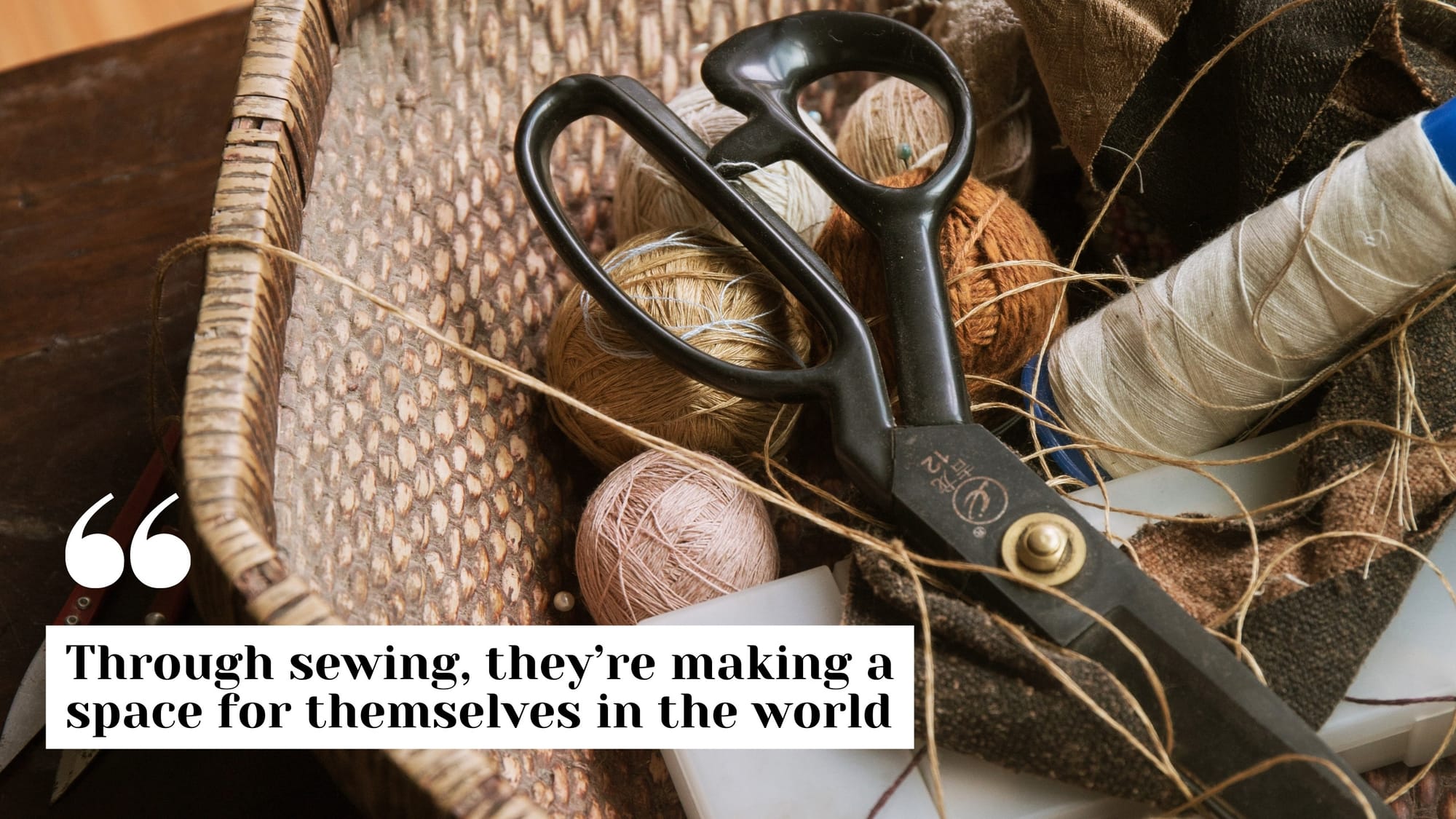Emotionally, socially, and practically, sewing is often heralded as a mindful wellbeing hack – but that’s nothing new. So, we spoke to historian and author Barbara Burman about sewings prominence in the past, and why it still matters today
On the middle finger on my left hand, there is a very small, red mark. About 15 years ago, I was working at a sewing machine when I lost focus and put the needle straight through that finger – the puncture never quite healed. It’s the kind of cautionary tale teachers tell rooms full of new sewists, but it also creates a metaphor for a feeling that may be familiar to the 7.7 million people the Craft & Hobby Trade Association say name sewing as a hobby: the impact of sewing lives on under our skin.
It’s a theme that runs through historian Barbara Burman’s book exploring the cultural history of sewing: The Point of the Needle: Why Sewing Matters. For Barbara, her own interest in sewing is something that can be traced back through her life.
“I grew up in a country vicarage, where there wasn’t very much money, and I had two very practical parents,” she recalls. “My mother actually taught sewing, dressmaking, and soft tailoring, so I was surrounded by people making things and talking about tools.
“My interest in sewing comes from an interest in the history of ordinary people, particularly women’s lives. I feel that it’s a kind of untold story. We’re so used to it that we don’t think about it. We put our clothes on, and there we are. But I wanted to look at what stitching actually means at an individual level, as well as a more global level.”
We herald the invention of electricity and countless other innovations – but sewing, despite the fact that we couldn’t go about our daily lives without it, is often overlooked. When I ask Barbara why the story of sewing is largely untold, she has some insight.

“Mostly because it’s associated so thoroughly with women, and women have always been, as it were, ‘second rate’,” she explains. “We’ve also lived with this quite spurious distinction between working with our brains and working with our hands. So manual work is thought of as secondary to headwork. But, in fact, our hands, and particularly our sense of touch, give us such a huge amount of information and agency in the world.”
These days, we often talk about how beneficial crafts can be for our mental health and wellbeing, with countless studies confirming this link in action. One such example is a 2022 study by Catherine Howard et al, published in the Journal of Textile Design Research and Practice. Researchers worked with pupils in year 9 of a school in Birmingham, who took part in weekly hour-long relaxed stitching sessions across two months. The results were not only a variety of inventive and impressive sewn creations, but also an overall increase in feelings of pride, and improved self-esteem and confidence. Pupils chatted while they worked, and the study became part of a wider mental health campaign in the school – turning into a demonstration of creative approaches to wellbeing working in action.
But while the terminology may be different, Barbara traces how sewing has been talked about in this manner throughout history. In her book, she points to an 1844 sewing manual that, as well as covering the practical aspects, goes on to expand on the emotional benefits of the practice. She also refers to journalist Flora Klickmann (1867–1958) who wrote about turning to needlework for solace at the end of the day, as well as several examples in literature where sewing comes with quiet contemplation and moments of bonding. That said, the benefits of sewing aren’t always quiet. In fact, often, they can be both loud and bold.
As part of the project called ‘Our Sewing Stories’, more than 100 people sent their sewing autobiographies to Barbara,sharing what the craft means to them. Many of the stories are dotted throughout her book, each one stirring up familiar feelings.
“So many people told me about the very nurturing sense of somehow belonging through making things,” she says. “Through sewing, they’re making a space for themselves in the world. If you take gender, for example, gender is a very fluid concept now, and people may not feel completely comfortable in the clothes that the high street is offering. But if they can make things of their own that do express what they feel themselves to be, then they feel they’re much more in a positive place.
“The same would be true of what you might call ‘political stitching’. If you’re making a banner for the next march you’re going to go on, making that banner can be a therapeutic thing, because you are making a statement. You’re expressing yourself in public. You’re taking a stand. You’re communicating, and you’re part of a community.”

Whether in the middle of a protest or the living room, community and sewing often go hand in hand.
“I think, sometimes, that connection comes through in an unexpected way,” adds Barbara. “A lot of people have told me about their sewing machines and their love of their sewing machines, or a thimble or a sewing basket; something that they’ve inherited within their family, or been given to them by friends. That is a kind of connection. You pick up a pair of scissors that were your mother’s, for example. Or when you’re part of a group, you may not know the people, but there is a deep connection, because you share that innate knowledge about what it’s like to stitch.”
With all this in mind, I ask Barbara whether she has a sewn piece that is particularly meaningful to her.
“Yes,” she answers. “I’m leaning on one now! It’s a patchwork hexagonal cushion that my mother made. It’s patchwork on both sides, but the front is made up of old dress fabrics. She stuffed it with lavender that she’d grown, and it still has an aroma of lavender. The stitches are really invisible. She was such a good stitcher. My father had made her copper templates for sewing around and making the patches, so she had really good, sharp edges. Yes, that means a lot.”
When we’re looking to take steps into the future, it can sometimes pay to look back at what’s behind us. In her book, Barbara’s exploration of the history of sewing is packed with reflections that will move us to consider the way sewing can support us in so many capacities. For the young or old, fresh or seasoned, for practical reasons or for our sense of wellbeing, without a doubt we can say: sewing matters.

Happiful readers can get 20% off copies when ordering directly from Reaktion using code POINT24. Offer exclusively redeemable on reaktionbooks.co.uk, until 31 December 2024, UK orders only.
Photography | Louise Jasper Photography.


Comments